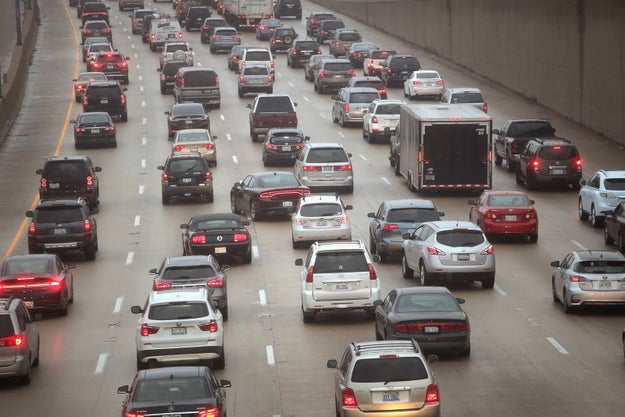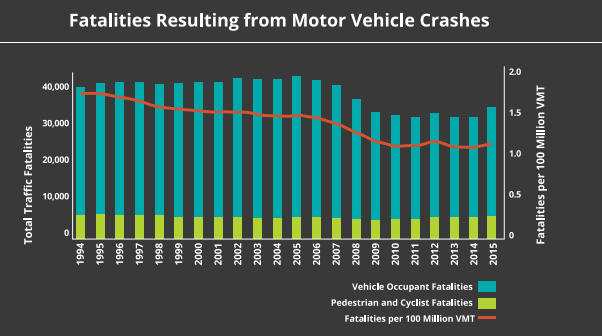
Travelers sit in a massive traffic jam as people hit the road for the holiday weekend on November 23, 2016 in Chicago, Illinois.
Scott Olson
The Trump administration will take over at a time when transportation in the US is undergoing somewhat of a revolution: the introduction of self-driving cars, an increasing reliance on ride-hail, and the privatization of public transit, to name a few.
Under its outgoing leader Anthony Foxx, the US Department of Transportation has begun preparing for the industry’s shift. Foxx led the agency as it drafted a 30-year report, presented at Google, on moving “beyond traffic” and released the first set of federal guidelines for autonomous vehicle development. Now, the agency has released the final draft of its 30-year report – a 238-page document that outlines the current state and future of transportation and infrastructure, as well as the challenges that Trump’s pick for secretary of transportation, Elaine Chao, will face.
Here are six things to know about the future of transportation:
1. Good luck with that hyperloop, guys.
Hyperloop, the moonshot technology project proposed by Elon Musk that involves cramming people in a tube and jetting them across long distances quickly (think San Francisco to Los Angeles in 30 minutes), “could one day rival high-speed rail as a mode of high-speed surface travel,” according to the report.
But not so fast. As the report points out, there are plenty of technical and practical difficulties looming for the hyperloop, not to mention the fact that one company attempting to develop it is dealing with internal turmoil.
“To name just one of the many challenges facing this technology, Hyperloop systems must travel in straight lines and would require significant right of way,” the report reads. “This could make construction of a Hyperloop system near and through populated areas prohibitively expensive.”
2. Uber everywhere.
The agency’s first report in 2015 noted that public transit agencies had started emulating Uber, for example, by accepting fares through an app. Since then, local transportation agencies have gone beyond simply copying Uber: Now they’re subsidizing ridehail outright for passengers.
This is one of Uber’s strategies for expanding beyond dense cities to conquer the suburbs. Summit, New Jersey, a suburb outside of New York, earlier this year offered residents the option to Uber to the local train station at the same cost as paying for a parking spot there. Subsidizing Uber allowed a clear benefit for Summit: forgoing millions of dollars in capital expenditures to build a new parking lot to meet demand.
“These services may make it more likely that households decide to go car free,” the report notes. Over the long haul, that could mean less revenue from gas tax, which funds roads and bridges. “It might also mean that we have learned to live with an inadequate, congested transportation system by traveling less.”
“The recent emergence of [ride-hailing] businesses demonstrates a key challenge for governments,” the report reads. “Over the next 30 years, our legal and regulatory system may be increasingly challenged by emerging forms of business and travel that transcend traditional legal and planning concepts.”

Department of Transportation
3. Self-driving cars are inevitable...
Secretary Foxx told BuzzFeed News that he thinks self-driving cars will go mainstream within five years. The report echoes that sentiment.
“The development of advanced automated vehicle safety technologies, including fully self-driving vehicles, may prove to be the greatest personal transportation revolution since the popularization of the personal automobile nearly a century ago,” the report says.
The technology is still under development at tech companies like Google and Uber, which are already testing self-driving cars on public roads, among other companies, and at traditional automakers such as Ford and General Motors. Many in the industry expect self-driving cars to make roads safer by eliminating human error, which accounts for 94% of accidents. That said, self-driving cars could make mistakes too: One of Uber’s test vehicles recently ran a red light in San Francisco – though the company said that it happened after a human had taken control of the car.
4. ...but there are plenty of challenges to resolve before they become mainstream.
While autonomous vehicles are widely expected to make roads safer by eliminating human error and distracted and drunk driving, they will also invite new challenges.
“New transportation services are at risk of repeating patterns of economic and racial inequities in transportation."
How do you make sure a self-driving vehicle, which is equipped with even more computers to power the car than a traditional vehicle, is secure from hackers? How can automakers and software companies ensure people who ride in these vehicles can maintain their privacy? Perhaps more immediately relevant: What happens to drivers when their jobs are automated?
“Entire business models and professions would be created, transformed, or eliminated as robotic taxis and driverless freight become possible,” the report says. “The broader effects on society are subject to debate, with uncertainty surrounding whether automated vehicles will curtail or enable sprawling land use patterns.”
5. Policymakers must also grapple with increasing economic inequality, which is reflected in access to transportation options.
“New transportation services such as bike-share systems and [ride-hailing] are at risk of repeating patterns of economic and racial inequities in transportation,” the report says. “Public-private partnerships in support of transit-oriented development could help to increase the amount of affordable housing with access to transit.”
(Many reports over the years have documented economic disparities associated with public transportation: wealth tends to cluster closer to transit lines.)
6. The US will need to do something about its crumbling infrastructure.
“Transportation agencies at all levels and across all modes face serious financial challenges that limit their ability to maintain our existing transportation system, let alone invest in the transportation system of tomorrow,” the report says. “As resources have become increasingly constrained, governments are being forced to make hard choices about whether to maintain services on roads and facilities that are less economically important.”
Case in point: About 58% of US roads are in “less than good” condition, according to the report. And 23% of bridges “need significant repair or can’t handle today’s traffic.”
In his campaign, president-elect Trump proposed a 10-year, $1 trillion infrastructure plan. In a fact sheet on the transition website, the campaign said the plan would help create a “a reliable and efficient transportation network” and “ensure we can export our goods and move our people faster and safer. (That page has since been removed.)
“If we want our nation to continue to support a world-class transportation system that can meet the needs of a growing population and a growing economy,” the DOT report says, “we will need to raise funding levels to support the necessary public investment, and we will need policies that spur private investment.”
from BuzzFeed - Tech https://www.buzzfeed.com/priya/6-things-to-know-about-the-future-of-transportation?utm_term=4ldqpia
No comments:
Post a Comment